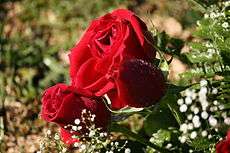Rose (symbolism)


The rose has long been used as symbols. "Rose" means pink or red in a variety of languages (such as the Romance languages and Greek).
In religion
Christianity
The rose was an icon of veneration in the pre-Christian era, and was used in ancient Rome to symbolize devotion to the goddess Venus. Following the Christianization of Rome under the emperor Constantine, the rose became identified with the Virgin Mary.[1] The rose symbol eventually led to the creation of the rosary and other devotional prayers in Christianity.[2]
Islam and Sufism
The cultivation of geometrical gardens, in which the rose has often held pride of place, has a long history in Iran and surrounding lands.[3][4] In the lyric ghazal, it is the beauty of the rose that provokes the longing song of the nightingale[5] - an image prominent, for example, in the poems of Hafez.[6]
In turn, the imagery of lover and beloved became a type of the Sufi mystic's quest for divine love, so that Ibn Arabi, for example, aligns the rose with the beloved's blushing cheek on the one hand and, on the other, with the divine names and attributes.[7]
Other well-known examples of rose symbolism in Sufism include;
- The Sufi master Jilani is known as "the Rose of Baghdad" and his order, the Qadiriyya, uses the rose as its symbol.
- Two prominent books aligned with Sufism are The Rose Garden by Saadi and Mahmud Shabistari's The Rose Garden of Secrets.
In Europe

Catalonia
Catalonians have traditionally celebrated Saint George's Day (April 23)—which commemorates Saint George (Sant Jordi), the patron saint of Catalonia—as the dia dels enamorats (lovers' day), on which lovers exchange blood-red roses.[8]
England

The rose is the national flower of England, a usage dating back to the English civil wars of the fifteenth century (later called Wars of the Roses), in which a red rose represented the House of Lancaster, and a white rose represented the House of York.[9] The Tudor dynasty created the Tudor rose, which united both the white and the red roses, a symbolism dramatized by Shakespeare in his play Richard III.[10][11] The traditional ballad "The Rose of England" (Child 166) recounts the seizure of the crown by Earl of Richmond (who became Henry VII of England, the founder the Tudor dynasty), using the "red rose" as an allegory for Henry.[12]
The England national rugby union team and Rugby Football Union adopted the red rose as their symbol in 1871, and the rose has appeared on players' kit ever since.[13]
In North America

United States
In 1986, the rose was adopted as the national floral emblem of the United States.[14][15]
It is the state flower of four U.S. states:
- Iowa - the wild rose was adopted as the state's flower in 1896.[16]
- North Dakota - The wild prairie rose was adopted as the official state flower of North Dakota in 1907. The colors of the rose (green and pink) had previously been adopted by the first graduating class of the University of North Dakota in 1889.[17]
- Georgia - the Cherokee rose (R. laevigata) was adopted as the state's official floral emblem in 1916.[18]
- New York - In 1955, the state adopted the rose as the state flower; the legislation stated: "The rose shall be the official flower of the state in any color or combination of colors common to it."[19]
Portland, Oregon has counted "City of Roses" among its nicknames (see roses in Portland, Oregon) since 1888,[20] and has held an annual Rose Festival since 1905.[21] The city is also known for its International Rose Test Garden.[20]
Pasadena, California—also nicknamed the "City of Roses"—has held the annual Tournament of Roses Parade since 1890, and 1902 the Parade has been held in conjunction with the Rose Bowl Game (which is now played at the city's Rose Bowl stadium, built in 1922).[22][23]
In April 2011, the U.S. government's space program agency, the National Aeronautics and Space Administration (NASA), celebrated the Hubble Space Telescope's 21st anniversary by releasing an image of spiral galaxies Arp 273 positioned in a rose-like shape.[24]
The red rose is also the official symbol for the Democratic Socialists of America (DSA).[25]
Canada
In 193, Rosa acicularis (the wild rose or prickly rose) was adopted as the official provincial flower of the Canadian province of Alberta. The suggestion that a provincial floral emblem be adopted by first made by an Edmonton newspaper editor; "the Women's Institutes took up the suggestion and passed it on to the Department of Education, and the province's schoolchildren made the final choice."[26][27]
The Wildrose Party, a now-defunct Albertan political party, was named after the province's official flower.[28]
Mexico
The Mexican city of Guadalajara, the capital of Jalisco, is nicknamed the "City of Roses" (Ciudad de las Rosas).[29][30]
Socialism and social democracy
The Tamiment Library and Robert F. Wagner Archives at New York University states that the rose "has always been an important symbol with anti-authoritarian associations."[31] The rose symbol became popular among socialist and social democratic political parties in post-World War II Europe.[31] The symbol of a rose in a fist is used by the Socialist International "and many of its member parties" such as the French Socialist Party (PS).[32]
The British Labour Party has used a red rose as its symbol since the late 1980s; the rose replaced the party's previous symbol, the red flag.[33][34]
In the world today
Other
The White Rose was a World War II non violent resistance group in Germany.
Gallery
| Wikimedia Commons has media related to roses as symbols. |
 A Rose Made of Galaxies
A Rose Made of Galaxies- Love & Hate
See also
References
- ↑ Lisa Cucciniello, "Rose to Rosary: The Flower of Venus in Catholicism" in Rose Lore: Essays in Semiotics and Cultural History (ed. Frankie Hutton: Lexington Books, 2008), pp. 64-65.
- ↑ Cucciniello, Rose Lore, at pp. 65-67.
- ↑ http://lj.uwpress.org/content/4/1/23.short
- ↑ http://onlinelibrary.wiley.com/doi/10.1111/j.1478-1913.1941.tb00950.x/abstract
- ↑ Diba, Layla S. (2001). "Gol o bolbol". In Yarshater, Ehsan. Encyclopædia Iranica. 11. London and New York: Routledge. pp. 52–57. Retrieved 15 November 2013.
- ↑ Julian Baldick in History of Persian Literature - Google Books;
- ↑ Ibn Arabi, The Tarjuman al-Ashwaq, Trans. R.A.Nicholson, Theosophical Publishing House 1911/1978, p 130, 145
- ↑ Matthew Tree, St George's Day with a Catalan twist, The Guardian (April 23, 2011).
- ↑ Peter Childs, "Places and Peoples: Region and Nation" in British Cultural Identities (4th ed.: eds. Mike Storry & Peter Childs; Routledge, 2013), p. 43.
- ↑ George Goodwin, Fatal Rivalry: Flodden, 1513: Henry VIII and James IV and the Decisive Battle for Renaissance Britain (W. W. Norton: 2013), p. 11.
- ↑ Jon Robinson, Court Politics, Culture and Literature in Scotland and England, 1500-1540 (Ashgate: 2008), p. 44.
- ↑ Natascha Würzbach & Simone M. Salz, Motif Index of the Child Corpus (Walter de Gruyter, 1995), pp. 175-76.
- ↑ Rugby History: Evolution of the England Kit, Rugby Football Union.
- ↑ 36 U.S.C. § 303 ("The flower commonly known as the rose is the national floral emblem.").
- ↑ Stephen Buchmann, The Reason for Flowers: Their History, Culture, Biology, and How They Change Our Lives (Simon & Schuster, 2016), p. 218.
- ↑ Linda Naeve, Iowa's State Flower - the Wild Rose (September 13, 1996), Horticulture & Home Pest News (Iowa State University Extension and Outreach).
- ↑ Wild Prairie Rose, State Historical Society of North Dakota.
- ↑ Georgia State Flower (Cherokee Rose), GeorgiaInfo: An Online Georgia Almanac, Digital Library of Georgia.
- ↑ New York State Flower - Rose, New York State Library.
- 1 2 Rosa Inocencio Smith, Orbital View: City of Roses, The Atlantic (May 5, 2016).
- ↑ Coming Up Roses, Fodor's (2006) (republished by the New York Times).
- ↑ Michelle Huneven, 37 Hours: Pasadena, Calif., New York Times (September 19, 2003).
- ↑ The Rose Bowl's Storied History, New York Times (December 31, 2013).
- ↑ NASA's Hubble Celebrates 21st Anniversary with 'Rose' of Galaxies, NASA, April 20, 2011, retrieved January 1, 2014
- ↑ "What Is Democratic Socialism?". Democratic Socialists of America. Retrieved December 15, 2015.
- ↑ Alberta (AB) - Facts, Flags and Symbols, Government of Canada (accessed May 24, 2016).
- ↑ Wild Roses, Canadian Wildlife Federation (accessed May 24, 2016).
- ↑ The rise and fall of the Alberta Wildrose Party, CBC News (December 18, 2014).
- ↑ The Mexican 'City Of Roses' Where Americans Feel At Home, Philadelphia Inquirer wire services (October 11, 1987).
- ↑ Bob Brooke, The Everything Family Guide To Mexico: From Pesos to Parasailing (Adams Media, p. 236).
- 1 2 About Our Logo, Tamiment Library and Robert F. Wagner Archives, New York University (accessed May 25, 2016).
- ↑ Historical Dictionary of Socialism (Rowman & Littlefield, 2015), p. 167.
- ↑ The rise and fall of New Labour, BBC News (August 3, 2010).
- ↑ Thomas William Heyck, A History of the Peoples of the British Isles (Vol. 3: Psychology Press, 2002), p. 312.